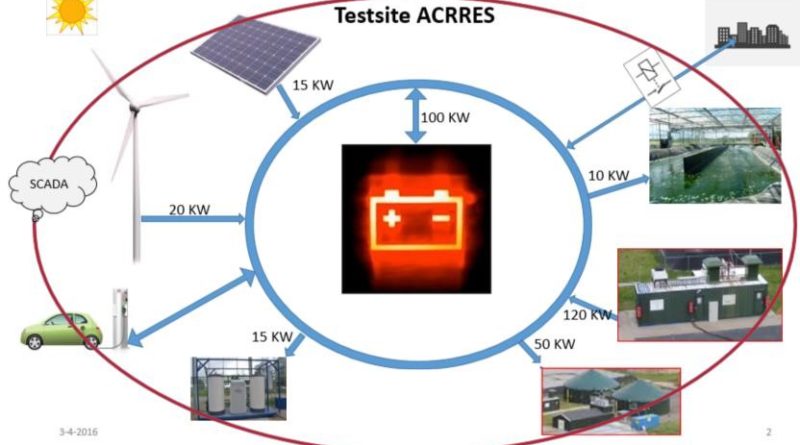A Smart grid integrating renewable energy sources, power storage, households and electric vehicle chargers
EnergyKeeper aims to implement a flexible, interoperable, reliable, secure, profitable and smart grid that integrates renewable energy sources, power storage, households and commercial consumers, and electric vehicle chargers. The heart of this system will be a 350 kWh redox flow battery with a capacity of 100 kW equipped with an interoperable battery management system. This enables plug-and-play integration into the central network management system of the “smart grid”. In parallel, communication architectures, network control and demand-side management systems will be implemented to demonstrate the added value of using energy storage systems to provide system services in the distribution network. The developed technologies will be installed and thoroughly tested at the ACRRES test site in the Netherlands. Finally, several prosumer business models are being developed that target different types of users. These will demonstrate that the EnergyKeeper system provides end-users with economic benefits while stabilizing the power grid.
The work topics of the EnergyKeeper project range from the basic research of new materials in the laboratory to the construction of an intelligent and interoperable demonstration grid (Smart Grid). The following main topics are set here:
1. Research advanced storage solutions on a laboratory scale
The aim of this work package is the development of new redox couples, the synthesis of polymer electrolytes based on new redox couples, the scale-up optimization and the comprehensive characterization of the materials.
2. Construction and construction of an organic redox flow battery
An organic redox flow battery is being developed for integration into a smart grid. In a first step, the required specifications for the battery system are determined and a theoretical modeling (CFD, electrochemistry) of various system components is performed. Finally, the results are translated into an electrical and mechanical design and a prototype is constructed. This will be thoroughly tested, gradually optimized and integrated into the project’s Smart Grid at the ACRRES test site.
3. Measuring system, control interface and smart grid communication network
The aim of this work package is the development of a comprehensive network management system for the control of the smart grid, which optimizes the utilization of the organic redox flow battery and enables the basic interoperability in the network. The system can measure power consumption and flow in real time, predict functional modes, and respond quickly to changes in the network. To make this possible, new communication protocols are implemented and a smart grid control algorithm is developed. Finally, a control and monitoring interface for prosumers (consumers who are also producers) is established.
4. Integration, testing and optimization
All system components, ie the hardware and software of the individual project partners, will be combined at the ACRESS test site into a fully-fledged Smart Grid demonstration network to test, improve and validate the developments.
5. Prosumer business models
To economically operate the smart grid, business models for numerous applications (e.g., load management, load aggregation, micro-networks, distributed power generation) are analyzed, discussed, and compared. These business models will consider different types of aggregators. As a result, prototype business models for the new technology are being developed and incorporated into the smart grid control algorithm.
6. Politics, standards and privacy
In addition to practical work on the smart grid, the status of current energy policy measures and standards that are relevant to the project is being reviewed. One goal here is the development of suggestions for international standardization activities. In addition, an attempt is being made to link the innovative storage technology with the European energy policy and to analyze potential effects of the use of technology. Furthermore, data protection issues (USEF) in the field of energy generation, storage and use are questioned and strategies derived.

